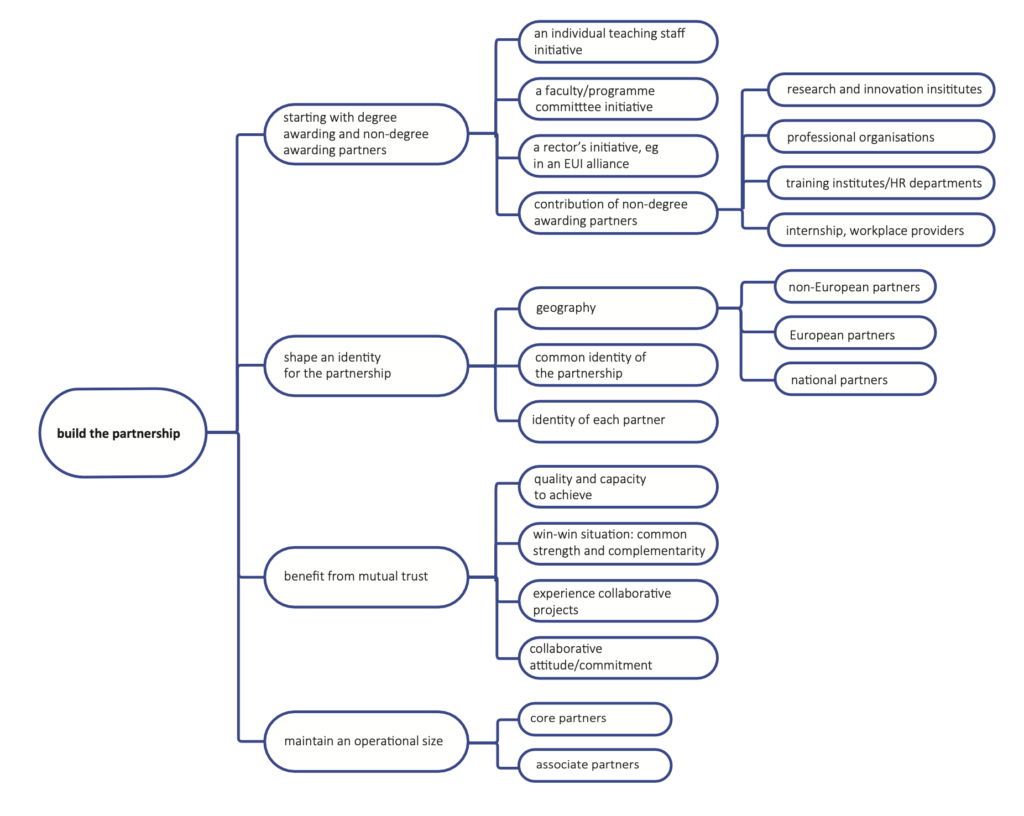
| The creation of the partnership for the micro-credential programme is based on several criteria: |
| Start with degree awarding and non-degree awarding partners; |
| Shape an identity for the partnership; |
| Benefit from mutual trust; |
| Maintain an operational size. |
Guidelines
Start with degree awarding and non-degree awarding partners
- The initiative for a joint micro-credential programme can be taken by an individual staff member, by a program committee at the faculty level, or by a rector or vice-rector at the institutional level, all possibly in the framework of a European University alliance (EUI) or another network;
- Non-degree awarding partners can contribute to the micro-credential programme to strengthen its research, innovation and professional foundation, eg research and innovation institutes, professional associations, sectoral training institutes and human resources departments of enterprises, and workplace providers offering internships.
Shape an identity for the partnership
- The identity of a partnership is to a large extent geographically determined by its national, European or international basis. Together, partners find a common identity in a conjoint research and innovation orientation or cooperation. Through this common identity, partners want also to keep their own profile.
Benefit from mutual trust
- Mutual trust is a basic condition for realizing a successful joint micro-credential programme. This is based on the educational, technological and organizational capacity of each partner institution to achieve its role. The programme should also create benefits for each single partner by the cooperation, creating win-wins by complementarity and multiplying effects.
- Partners show a long-term commitment to the micro-credential programme (at least 5 years) and a collaborative attitude.
Maintain an operational size
- Since the-set up of a micro-credential programme is a complex activity, the typical number of partners will vary from two to six partners. A higher number will be complicated as possibly more perspectives are to be reconciled and more institutional and national regulations have to be taken into account;
- In case more partners participate, core partners can take the lead while associate partners play a specific role, eg additional labs, specific seminars, mobility schemes, guest lectures, etc.
- Associate partners can include non-degree awarding institutions such as musea, national scientific institutions, professional organisations, business sectors or enterprises.
Observations
- Individual staff members start with the development of micro-credential programmes because of different motivations related to personal research and innovation in a particular scientific and professional domain. They can also be invited by colleagues of other universities or networks because of their reputation. In an early stage, they need a dialogue and an agreement with the faculty or the institution in order to comply with institutional rules for programming continuing education. From the beginning they should find consultation and support from different services in the university, notably teaching and learning, IT, international offices and legal services;
- Micro-credential programme initiatives at the level of a faculty or a programme committee have the advantage of collective decisions and direct support by faculty services. In many cases, they are a study track or a further specialisation of an existing bachelor or master programme. Faculty level initiatives are easier to integrate in institutional regulations;
- Micro-credential programmes initiatives at the institutional level benefit from the start a top-down support. The issue in some cases is to find a motivated leader at the faculty or individual staff level to design and develop the micro-credential programme. Institutional initiatives are taken to implement institutional strategies for continuing education and professional development or cooperation agreements within the university alliance or network. The institutions fulfill the necessary conditions for developing the micro-credential programme.
Recommendations
- A micro-credential programme partnership should have a strong basis, eg consisting of previous research ties or at least common research interests, expertise in innovation, mobility schemes or other internationalization projects. Universities should have similar institutional characteristics or policies for continuing education and professional development;
- Team leader and partners should start from a time horizon of at least five years, surrounding themselves locally with colleagues and services assuring sustainability;
- Collaborate with associate partners from the start as they are relevant for the cocreation of the programme and engage them for further curricular an extra-curricular collaboration.
next chapter: Compose the micro-credential programme team: structure and tasks
previous chapter: Define the macro-objectives of the joint micro-credential programme
back to overview: Models and guidelines for the design and development
of a joint micro-credential programme in higher education
